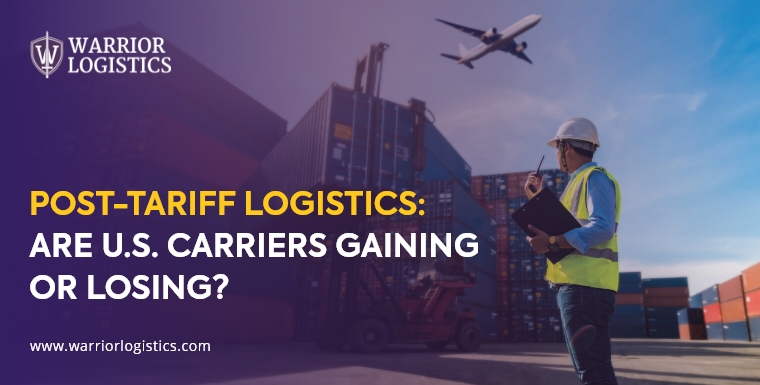Post-Tariff Logistics: Are U.S. Carriers Gaining or Losing?
The U.S.-China trade war made waves in global supply chains, and it’s left U.S. carriers with a lot to think about. Now that tariffs have become a regular part of the logistics conversation, the question is whether U.S. carriers are getting ahead or falling behind.
Tariffs, which are taxes on imported goods, have a significant impact on freight costs and the overall supply chain. They increase the price of goods, leading to higher freight rates, and can disrupt international trade, affecting supply chains and causing price volatility.
In this post, we’re diving into how tariffs have shaken up the industry and what U.S. carriers can do to make the most of it.
When Do Tariffs Go Into Effect?
Let’s start with the basics. Timing matters. Tariffs typically go live after the President signs an official order or an agreement is made between countries.
Back in April 2025, President Trump announced some hefty tariffs on Chinese imports, set to take effect on April 9th. For some goods, these tariffs were as high as 145%.
But there’s some light at the end of the tunnel: In May 2025, the U.S. and China came to a temporary agreement to cut these tariffs.
For a while, U.S. tariffs on Chinese goods dropped to 30%, while China also slashed tariffs on U.S. goods down to 10%.
But, even with the reduction, tariffs are still a big factor. When tariffs go into effect, they throw a wrench into the flow of goods. U.S. carriers feel that the strain, higher transportation costs, and disrupted schedules are inevitable. Even at ports like Los Angeles, a key entry point for U.S. goods, shipments slowed when tariffs first hit.
Trump Tariffs Explained
We’ve all heard about Trump’s tariffs. They were designed as a way to tackle the trade imbalance between the U.S. and other countries, especially China.
The goal was to make China reduce its trade barriers and open up more opportunities for U.S. businesses. However, the results have been mixed. While the tariffs may have helped certain industries, like steel and aluminum, other sectors, particularly logistics, have felt the sting.
For U.S. carriers, the situation got tricky. The increased tariffs meant higher shipping costs. Whether they were transporting electronics, vehicles, or other goods from China, carriers had to adjust.
That often meant taking longer routes or dealing with rising fuel costs. The automotive sector saw a slowdown in shipments, and overall, logistics operations became more expensive.
What was supposed to help some industries ended up putting a strain on others.
How Do Tariffs Impact the Economy?
When tariffs are slapped on imports, they create ripple effects throughout the economy. For consumers, the cost of goods goes up. It’s simple economics: when businesses have to pay higher prices for the goods they import, they often pass those costs down to consumers. And that means prices on everyday items go up.
For U.S. carriers, tariffs directly affect their operations. Higher operational costs can lead to fewer shipments or reduced profits. Additionally, as certain products become more expensive, consumer demand can drop, which means less volume for U.S. carriers to transport. This not only impacts bottom lines but also causes a slowdown in the economy.
Despite this, some experts argue that tariffs might be a necessary step in shifting global supply chains away from dependency on one or two countries. For U.S. carriers, this could open up new markets over time—if they’re able to adjust and adapt to these new trade dynamics.
China Tariffs on U.S. Goods
China’s tariffs on U.S. goods have been a major part of the trade war fallout. From soybeans to cars, China slapped tariffs up to 125% on many U.S. exports. This hit U.S. carriers hard—fewer goods to export meant fewer shipments and a drop in overall cargo volume.
But it’s not all bad news. With these tariffs still in play, U.S. businesses have been forced to look elsewhere for new trading partners. Southeast Asia and Latin America have become key markets for U.S. goods. This change has created new opportunities for U.S. carriers to diversify and adjust their routes and services to accommodate this shift.
The full impact of China’s tariffs on U.S. goods is still unfolding, and U.S. carriers will need to stay flexible to adapt to these changes. It’s a rough road ahead, but there’s potential for growth if the right opportunities are seized.
The Impact of Tariffs on U.S. Carriers: Gaining or Losing?
So, are U.S. carriers gaining or losing in the post-tariff world? Well, it’s a bit of both. On one hand, tariffs have led to higher operational costs and a reduction in overall cargo volumes.
On the other hand, tariffs have forced U.S. carriers to rethink their strategies and open doors to new trade routes and markets. As U.S. businesses shift away from China, carriers need to stay nimble, finding new opportunities to fill the gaps left by tariffs on China.
The key is adaptation. The carriers who succeed will be those who can lead the game, whether that means shifting focus to new markets or finding innovative ways to streamline operations and reduce costs.
Conclusion
Tariffs have brought a whirlwind of change to global logistics. For U.S. carriers, the challenge is balancing the immediate impacts of higher costs with the long-term opportunities that new trade relationships could bring. The landscape is shifting, and as always, flexibility is key.
Warrior Logistics has a Solution for All
At Warrior Logistics, we understand the power of adaptability and strategic thinking. That’s how The Warrior Difference works, and we continue to navigate the complexities of global trade and drive excellence in trucking, freight, flatbed, and other logistics services.
“The road ahead may have bumps, but with our right approach, you can emerge stronger, ready to face the post-tariff world head-on. To make your freight move hassle-free!“




